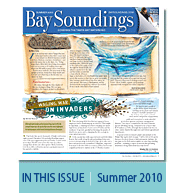 |
||||||||
It's Not Oil, But Black, Stinky Stuff Already in Tampa Bay
By Victoria Parsons

Photo by Victoria Parsons
TBEP invited local television stations to take a closer look at the muck at the bottom of Tampa Bay.
What’s thick, black, stinks and destroys habitat?
In Old Tampa Bay, the problem isn’t oil. It’s a thick layer of nasty muck composed primarily of crustacean poop. Populations of the bottom-dwelling creatures, fueled primarily by residential fertilizer, have boomed over the past decades, and they’ve deposited fecal matter in layers up to three feet deep in some parts of the bay.
And while the muck isn’t toxic, it bleeds the oxygen out of the water so very little can live in or near it – much like the dead zone at the mouth of the Mississippi River. “We’re nearing a tipping point,” said Ed Sherwood, scientist with the Tampa Bay Estuary Program. “The system could crash if nothing changes.”
Much of the attention has focused on the highly visible algal blooms that have plagued Old Tampa Bay over the past two summers, but scientists also have been studying the problem from the muck up.
A recently completed study led by Dr. Ernst Peebles of the University of South Florida’s College of Marine Science confirmed that residential fertilizer is an increasingly significant cause of the oxygen-deficient muck.
Bottom Changed Over Time
Funded through the Pinellas-Anclote Basin Board of the Southwest Florida Water Management District, the study looked at how the bay has changed in character and composition over time. By dating isotopes, Peebles’ team could trace the changing origins of nitrogen found in core samples at various depths.
In the 1940s, most of the nitrogen was associated with livestock wastes and human sewage. That began to change in the 1960s and ‘70s when residential fertilizer began to show up. About the same time, the Lake Tarpon outfall was completed, expanding the area that drains into Old Tampa Bay by 52 square miles when the county’s largest lake was connected the bay rather than the gulf.
The research also indicates that the rate at which the muck is accumulating has been accelerating in recent years – a trend that reflects ongoing population growth in north Pinellas County and an increased focus on suburban lawns and landscapes.
Cleaning up the muck will be practically impossible but scientists are hopeful that Pinellas County’s new fertilizer ban will slow the growth of the muck and excess algae. “Pinellas has a unique fertilizer ordinance that’s the most beneficial,” said Nanette O’Hara, TBEP’s public outreach coordinator. “It bans the application of fertilizer during the summer months when there’s the greatest potential for run-off. Next year, a retail sales ban will mean you can’t buy lawn fertilizer during the summer rainy season.”
Sarasota passed the region’s first fertilizer ban in 2007, followed by St. Petersburg and Pinellas County last year. Proposed state legislation that would have pre-empted local regulations failed to pass in the legislative session this Spring.
